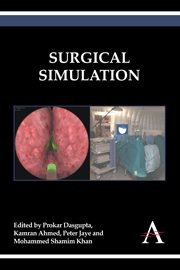Book contents
- Frontmatter
- Contents
- 1 Surgical Simulation: An Overview
- 2 Simulation in Historical Perspective: The History of Medical and Surgical Simulation
- 3 The Role of Animal Models in Surgical Training and Assessment
- 4 Full Procedural Surgical Simulation
- 5 Developing Non-technical Skills
- 6 Learning Curves for Simulators
- 7 Developing a Simulation Programme
- 8 Patient Safety and Simulation
- 9 Psychometrics
- 10 Future of Surgical Simulation
- Author Details
7 - Developing a Simulation Programme
Published online by Cambridge University Press: 05 April 2014
- Frontmatter
- Contents
- 1 Surgical Simulation: An Overview
- 2 Simulation in Historical Perspective: The History of Medical and Surgical Simulation
- 3 The Role of Animal Models in Surgical Training and Assessment
- 4 Full Procedural Surgical Simulation
- 5 Developing Non-technical Skills
- 6 Learning Curves for Simulators
- 7 Developing a Simulation Programme
- 8 Patient Safety and Simulation
- 9 Psychometrics
- 10 Future of Surgical Simulation
- Author Details
Summary
Introduction
Urology training has traditionally adopted an apprenticeship model whereby trainees are taught and overseen by senior surgeons in clinical settings and operating theatres. This method has thus far produced safe and competent surgeons. Although the operating theatre is regarded as the best learning resource, it is difficult to balance the benefit of learning from exposure to real patients with the potential harm to these patients if operated on by trainee surgeons. Also, the operating theatre is a stressful environment with time constraints and numerous distractions, making it a less than ideal stage for learning. To add to these challenges, trainees and trained surgeons alike must adapt to emerging innovations in urology such as laparoscopic and robotic technologies, which have steep learning curves. Furthermore, the reduction in trainee working hours and a shorter training period means that the largely opportunity-based apprenticeship model of training alone is no longer sufficient. Thus, the traditional urology training programme faces a number of challenges: providing ample learning opportunities with novel technologies in authentic environments without compromising patient safety, and within a shorter training period.
The use of simulators and inanimate trainers addresses many of these challenges. Simulators are products that mimic realistic tasks and situations in a controlled setting. Many types of simulations exist, from synthetic, animal and cadaveric organ models to mechanical and virtual reality simulators (a computer-generated representation of realistic environments that allow user interaction).
- Type
- Chapter
- Information
- Surgical Simulation , pp. 73 - 84Publisher: Anthem PressPrint publication year: 2014

